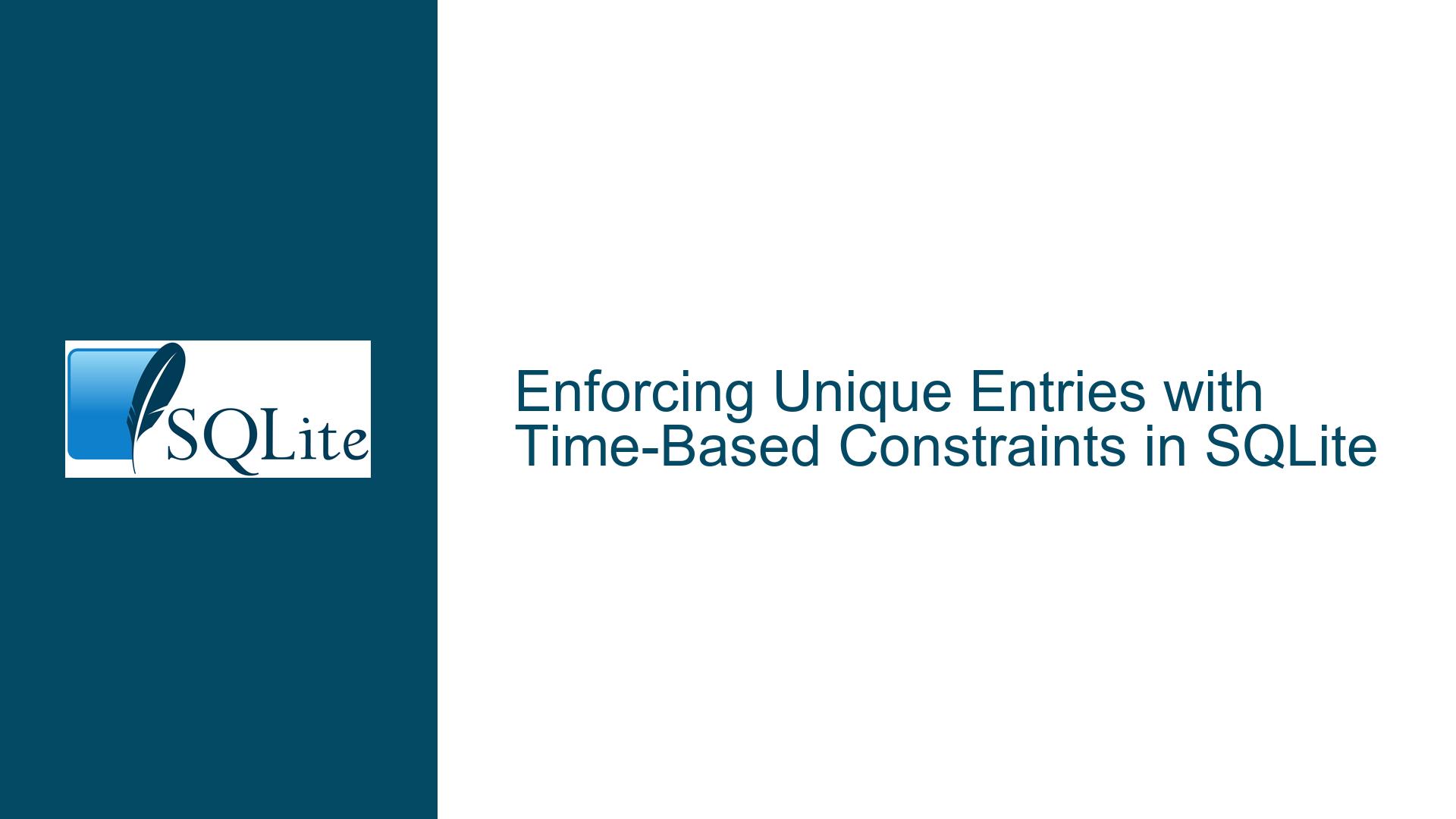Enforcing Unique Entries with Time-Based Constraints in SQLite
Unique Constraint with Time-Based Window Requirements
In SQLite, enforcing a unique constraint based on a combination of columns and a time-based window is a common requirement for applications that need to prevent duplicate entries within a specific time frame. For instance, you might want to ensure that a combination of col1, col2, and a timestamp dt is unique only if the entries are at least 10 seconds apart. This requirement is not natively supported by SQLite’s UNIQUE constraint, which only allows for simple column-based uniqueness. The challenge arises because SQLite prohibits expressions in PRIMARY KEY and UNIQUE constraints, making it impossible to directly enforce a time-based uniqueness rule.
The core issue revolves around the need to enforce a constraint that prevents new entries from being inserted if they fall within a specified time window (e.g., 10 seconds) of an existing entry with the same combination of col1 and col2. This requires a more sophisticated approach than a simple UNIQUE constraint, as it involves evaluating the timestamp of the new entry against the timestamps of existing entries.
Limitations of SQLite’s UNIQUE Constraint and Time-Based Grouping
SQLite’s UNIQUE constraint is designed to enforce uniqueness based on the values of one or more columns. However, it does not support expressions or functions within the constraint definition. This limitation becomes apparent when trying to enforce a time-based uniqueness rule. For example, attempting to use a UNIQUE constraint with a condition like dt BETWEEN dt AND datetime(dt, '+10 seconds') results in an error because SQLite does not allow expressions in UNIQUE constraints.
One proposed workaround is to create a derived column that rounds the timestamp to the nearest 10-second interval and then apply a UNIQUE constraint on the combination of col1, col2, and this derived column. However, this approach has a significant drawback: it enforces uniqueness based on fixed 10-second windows, which may not align with the actual timing of the entries. For example, if one entry is inserted at the last second of a 10-second window and another entry is inserted at the first second of the next window, they would be considered unique even though they are only 1 or 2 seconds apart.
This limitation highlights the fundamental challenge of enforcing time-based uniqueness in SQLite. The database engine does not natively support the concept of "boundary-less groupings," where entries are grouped based on their proximity in time rather than fixed intervals. This makes it impossible to enforce a rule that prevents entries from being inserted if they are within a specified time window of an existing entry.
Implementing Time-Based Uniqueness with Triggers and Indexes
Given the limitations of SQLite’s UNIQUE constraint, the most effective way to enforce time-based uniqueness is by using triggers. A trigger can be defined to check the timestamp of the new entry against the timestamps of existing entries and raise an error if the new entry falls within the specified time window. This approach allows for more flexible and accurate enforcement of time-based uniqueness rules.
The following trigger checks if a new entry is being inserted within 10 seconds of an existing entry with the same combination of col1 and col2. If such an entry exists, the trigger raises an error and prevents the insertion:
CREATE TRIGGER log_trig
BEFORE INSERT ON LOG
WHEN EXISTS(
SELECT 1 FROM LOG
WHERE col1 = NEW.col1
AND col2 = NEW.col2
AND dt >= datetime(NEW.dt, '-10 seconds')
)
BEGIN
RAISE(ABORT, 'Log too soon');
END;
This trigger uses the WHEN EXISTS clause to check if there is an existing entry in the LOG table that matches the combination of col1 and col2 and has a timestamp within 10 seconds of the new entry’s timestamp. If such an entry exists, the trigger raises an error with the message "Log too soon" and aborts the insertion.
To optimize the performance of this trigger, it is recommended to create an index on the combination of col1, col2, and dt. This index allows the trigger to quickly locate existing entries that fall within the specified time window, reducing the overhead of the trigger’s SELECT statement.
CREATE INDEX idx_log_col1_col2_dt ON LOG (col1, col2, dt);
This index ensures that the trigger’s SELECT statement can efficiently find relevant entries without scanning the entire table, making the trigger more scalable for large datasets.
Handling Edge Cases and Optimizing Performance
While the trigger-based approach effectively enforces time-based uniqueness, there are several edge cases and performance considerations to keep in mind. One potential issue is the handling of concurrent inserts. If multiple transactions attempt to insert entries with the same combination of col1 and col2 within the same time window, the trigger may not catch all violations due to the way SQLite handles concurrency.
To mitigate this issue, it is important to ensure that the LOG table is accessed in a serialized manner when performing inserts. This can be achieved by using SQLite’s BEGIN EXCLUSIVE TRANSACTION statement, which locks the table for the duration of the transaction, preventing other transactions from modifying the table until the current transaction is complete.
BEGIN EXCLUSIVE TRANSACTION;
INSERT INTO LOG (col1, col2, dt) VALUES ('value1', 'value2', '2023-10-01 12:00:00');
COMMIT;
By wrapping the insert operation in an exclusive transaction, you can ensure that the trigger’s check is performed atomically, reducing the risk of concurrent insert violations.
Another consideration is the performance impact of the trigger on large datasets. As the LOG table grows, the trigger’s SELECT statement may become slower, especially if the index on col1, col2, and dt is not used efficiently. To optimize performance, it is important to regularly analyze and optimize the index using SQLite’s ANALYZE command.
ANALYZE;
This command updates the statistics used by SQLite’s query planner, ensuring that the index is used efficiently for the trigger’s SELECT statement. Additionally, you may consider partitioning the LOG table based on col1 and col2 to further improve query performance.
Conclusion
Enforcing time-based uniqueness in SQLite requires a combination of triggers and indexes to overcome the limitations of the UNIQUE constraint. By using a trigger to check the timestamp of new entries against existing entries, you can effectively prevent duplicate entries within a specified time window. However, it is important to handle edge cases such as concurrent inserts and optimize performance for large datasets to ensure the solution is robust and scalable.
The following table summarizes the key components of the solution:
| Component | Description |
|---|---|
| Trigger | Checks if a new entry is within 10 seconds of an existing entry. |
| Index | Optimizes the trigger’s SELECT statement by indexing col1, col2, dt. |
| Exclusive Transaction | Ensures atomicity of the insert operation and trigger check. |
| Analyze Command | Optimizes the index for large datasets. |
By carefully implementing and optimizing these components, you can enforce time-based uniqueness in SQLite effectively, ensuring the integrity and accuracy of your data.






